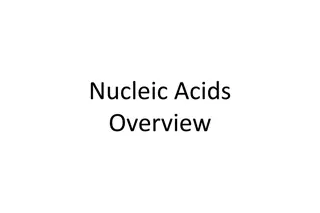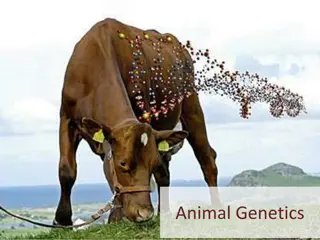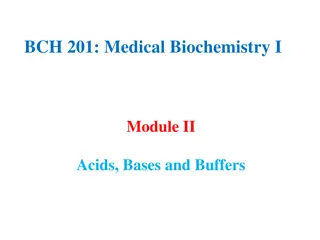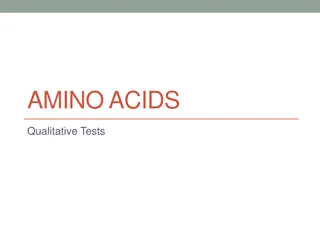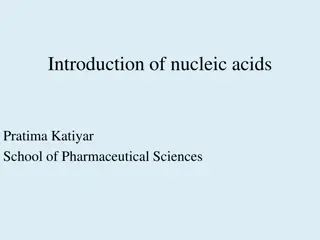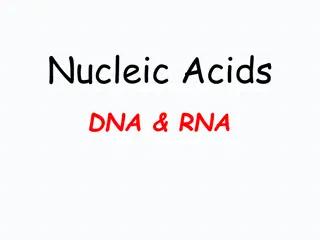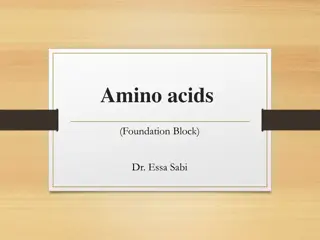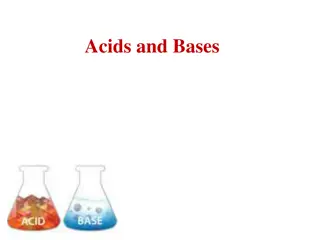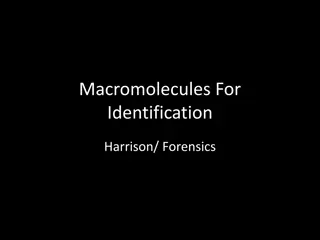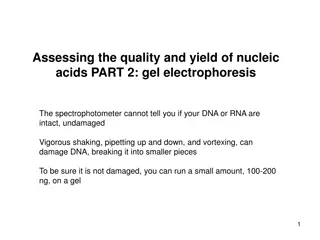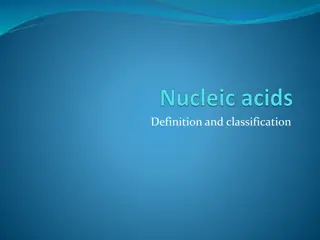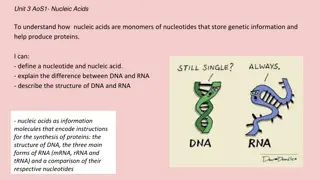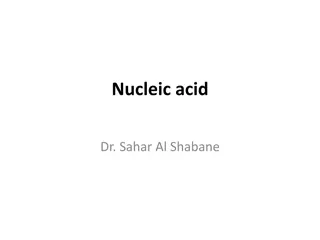Exploring the World of Nucleotides and Nucleic Acids
Discover the fascinating realm of nucleotides and nucleic acids through characteristic bases, pentoses, tautomeric forms of common pyrimidine and purine bases, electron-rich nature, UV absorption spectra, furanose structures, major and minor bases, nucleosides, and phosphodiester bonds linking successive nucleotides in DNA and RNA.
Download Presentation

Please find below an Image/Link to download the presentation.
The content on the website is provided AS IS for your information and personal use only. It may not be sold, licensed, or shared on other websites without obtaining consent from the author.If you encounter any issues during the download, it is possible that the publisher has removed the file from their server.
You are allowed to download the files provided on this website for personal or commercial use, subject to the condition that they are used lawfully. All files are the property of their respective owners.
The content on the website is provided AS IS for your information and personal use only. It may not be sold, licensed, or shared on other websites without obtaining consent from the author.
E N D
Presentation Transcript
Nucleotides and Nucleic Acids Have Characteristic Bases and Pentoses
The common pyrimidine bases cytosine, uracil, and thymine in the tautomeric forms predominant at pH 7.
The common purine bases adenine and guanine in the tautomeric forms predominant at pH 7.
The Properties of Pyrimidines and Purines Can Be Traced to Their Electron-Rich Nature The keto enol tautomerization of uracil. The tautomerization of the purine guanine.
Some minor purine and pyrimidine bases, shown as the nucleosides
Some minor purine and pyrimidine bases, shown as the nucleosides
Phosphodiester Bonds Link Successive Nucleotides in Nucleic Acids
Phosphodiester linkages in the covalent backbone of DNA and RNA.
Phosphodiester linkages in the covalent backbone ofDNA and RNA.
The Properties of Nucleotide Bases Affect the Three-Dimensional Structure of Nucleic Acids: UracilTautomeric forms of uracil
Hydrogen-bonding patterns in the base pairs defined by Watson and Crick
Hydrogen-bonding patterns in the base pairs defined by Watson and Crick
SUMMARY A nucleotide consists of a nitrogenous base (purine or pyrimidine), a pentose sugar, and one or more phosphate groups. Nucleic acids are polymers of nucleotides, joined together by phosphodiester linkages between the 5'- hydroxyl group of one pentose and the 3'- hydroxyl group of the next. There are two types of nucleic acid: RNA and DNA. The nucleotides in RNA contain ribose, and the common pyrimidine bases are uracil and cytosine. In DNA, the nucleotides contain 2'-deoxyribose, and the common pyrimidine bases are thymine and cytosine. The primary purines are adenine and guanine in both RNA and DNA.
References: Lehninger Principles of Biochemistry (Nelson W. H. Freeman. 4th Ed, 2004). Biochemistry (Reginald H. Garrett and Charles M. Grisham, University of Virginia 4th Ed, 2010).
ahmed.mohamed@fagr.bu.edu.eg http://www.bu.edu.eg/staff/ahm edmohamed6


